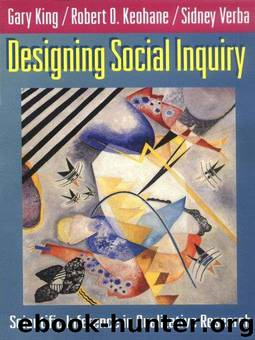Designing Social Inquiry: Scientific Inference in Qualitative Research by Verba Sidney

Author:Verba, Sidney [Verba, Sidney]
Language: eng
Format: mobi
Publisher: Princeton University Press
Published: 1994-05-01T16:00:00+00:00
Figure 4.1 Selection Bias
Now suppose an incoming business-school student were interested in studying how he could increase his starting salary upon graduation. Not having learned about selection bias, this student decides to choose for study a sample of previous students composed only of those who did well in their first job—the ones who received jobs he would like. It may seem that if he wants to learn about how to earn more money it would be best to focus only on those with high earnings, but this reasoning is fallacious. For simplicity, suppose the choice included only those making at least $100,000. This sample selection rule is portrayed in figure 4.1 by a solid horizontal line at Y = 10, where only the points above the line are included in this student’s study. Now, instead of fitting a regression line to all the points, he fits a line (the dashed line) only to the points in his sample. Selection bias exerts its effect by decreasing this line’s slope compared to that of the solid line. As a result of the selection bias, this student would incorrectly conclude that each additional accounting course is worth only about $5,000.
This is a specific example of the way in which we can underestimate a causal effect when we have selection on the dependent variable. Luckily, there is something our student can do about his problem. Suppose after this student completes business school, he gets bored with making money and goes to graduate school in one of the social sciences where he learns about selection bias. He is very busy preparing for comprehensive examinations, so he does not have the time to redo his study properly. Nevertheless, he does know that his starting salary would have increased by some amount significantly more than his estimate of $5,000 for each additional accounting class. Since his selection rule was quite severe (indeed it was deterministic), he concludes that he would have made more money in business if he had taken additional accounting classes—but having decided not to maximize his income (who would enter graduate school with that in mind?)—he is thankful that he did not learn about selection bias until his values had changed.
Download
This site does not store any files on its server. We only index and link to content provided by other sites. Please contact the content providers to delete copyright contents if any and email us, we'll remove relevant links or contents immediately.
Cecilia; Or, Memoirs of an Heiress — Volume 1 by Fanny Burney(31333)
Cecilia; Or, Memoirs of an Heiress — Volume 3 by Fanny Burney(30934)
Cecilia; Or, Memoirs of an Heiress — Volume 2 by Fanny Burney(30889)
The Great Music City by Andrea Baker(21313)
We're Going to Need More Wine by Gabrielle Union(18074)
Bombshells: Glamour Girls of a Lifetime by Sullivan Steve(13109)
Pimp by Iceberg Slim(12931)
All the Missing Girls by Megan Miranda(12750)
Fifty Shades Freed by E L James(12451)
Norse Mythology by Gaiman Neil(11883)
Talking to Strangers by Malcolm Gladwell(11879)
Crazy Rich Asians by Kevin Kwan(8349)
Mindhunter: Inside the FBI's Elite Serial Crime Unit by John E. Douglas & Mark Olshaker(7834)
The Lost Art of Listening by Michael P. Nichols(6474)
Enlightenment Now: The Case for Reason, Science, Humanism, and Progress by Steven Pinker(6406)
Bad Blood by John Carreyrou(5769)
The Four Agreements by Don Miguel Ruiz(5511)
Weapons of Math Destruction by Cathy O'Neil(5037)
We Need to Talk by Celeste Headlee(4870)
